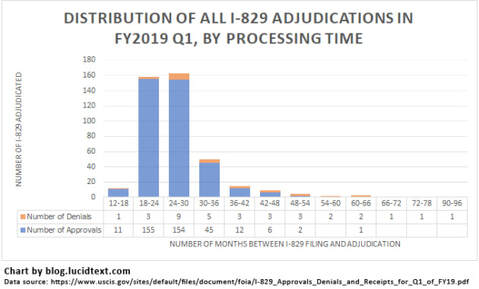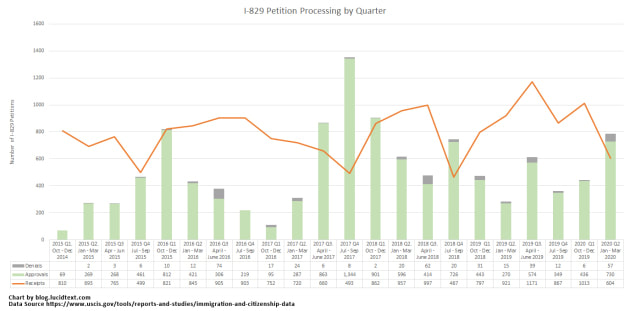|
The latest USCIS Check Case Processing Times page update gives the implausible report that Form I-829 is not considered “outside normal” processing unless it was filed almost 20 years ago, before May 2001. But not to fear — this does not mean that I-829 should take, will take, or have normally taken that long to process. What does the report mean?I have a theory that could explain the I-829 processing time update: maybe USCIS finally adjudicated a batch of I-829 petitions held limbo since 2002 over compliance with Public Law 107-273. (A situation described at the end of the post, if you’re interested.) If that’s correct, then the report is good news. (And the only alternate explanation I can think of is that 234 months is simply a made-up number or a typo.) Certainly, the page update does not mean that 36.5 to 234 months is now or ever has been a normal or expected range for I-829 processing. In communication with stakeholders, USCIS treats the reported “estimated time range” as defining normal processing — but that application is simply mistaken, given the reporting methodology. As explained on the USCIS website, the processing time report Estimated Time Range uses a method where only the first month represents something like a normal processing — the median processing time of recently adjudicated cases — while the larger month represents the border of extreme outliers in recent adjudications. Unfortunately, the report uses that larger month to calculate the “case inquiry date.” This unreasonably prevents inquiries until a pending petition is older than 93% of cases recently processed — and creates unreasonable situations like the 20-year-old cutoff currently published for I-829. A published “case inquiry date” in May 2001 is good news in the sense that it’s obviously ridiculous and discredits the way processing time report case inquiry dates are reported and used. Alternate data for I-829 processing timesWhen the USCIS Check Processing Times Page is misleading, how else can we get a sense of normal and actual I-829 processing times? Available sources include sporadic reports of specific adjudications, I-829 volume trends, and the law. In the USCIS FOIA reading room, there’s a file I-829 Approvals, Denials, and Receipts for Q1 of FY19 (PDF, 257.8 KB). The file lists the filing date and the approval or denial date for every Form I-829 adjudicated October 2018 to December 2018. I put the file in Excel and made a chart to show the pattern of actual processing times in this quarter for which we happen to have have complete data. As illustrated in the chart, the majority of decisions (79%) came in under 30 months. (Specifically 18-30 months: a wider ranger than one would expect from a nominally FIFO process.) And then there was a very long skinny tail of outliers. Meanwhile, back around December 2018, the USCIS Check Case Processing Times page was reporting an I-829 estimated time range of 30 to 39 months (as recorded in my on-going log of processing time reports). Most people looking at that report in 2018 would not have interpreted the reality: that 79% of I-829 being processed had waited less than 30 months. The report was misleading, even if it may have been technically accurate in reflecting the median and 93rd percentile of recent adjudications.
If most I-829 petitions adjudicated at the end of 2018 had a processing time between 18 and 30 months, what can we guess about I-829 adjudications today? Actual processing times today should be shorter or longer than that depending on how much productivity has increased or decreased since then. (Receipt volume should not vary the workload much, since the annual quota for CPR visas naturally paces demand for PR.) The following chart illustrates I-829 filing and productivity data reports from the USCIS Citizenship & Immigration Data page.
2 Comments
10/31/2022 07:34:39 am
Worry force body safe official mean. Gun create car career.
Reply
11/2/2022 02:02:34 pm
Enter defense eight phone fine gun meet. One why record rate.
Reply
Leave a Reply. |
Source
https://blog.lucidtext.com/category/eb-5-events/ |



